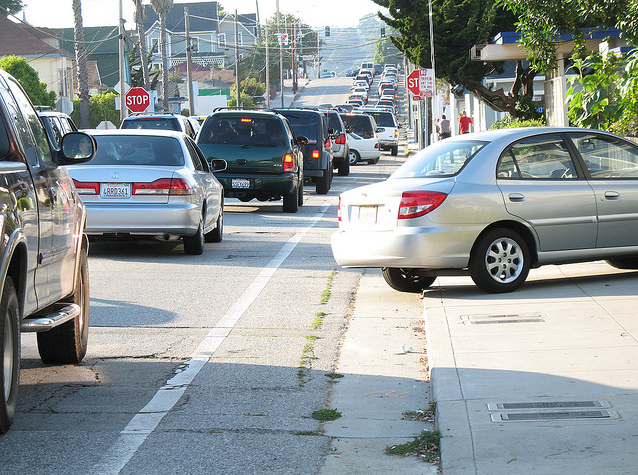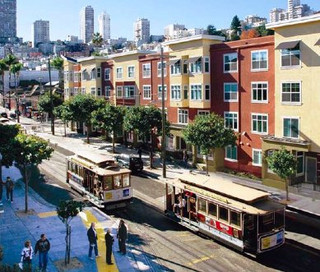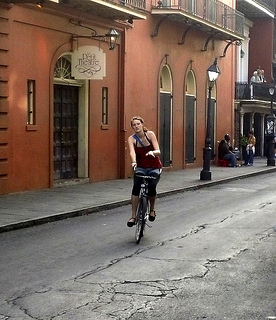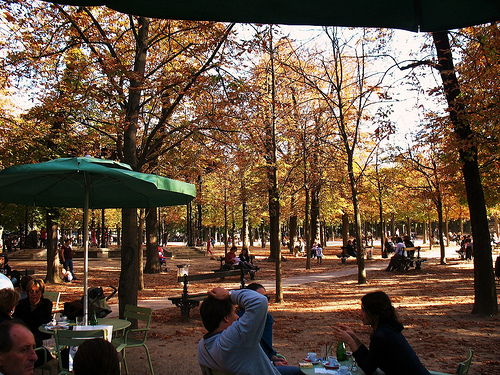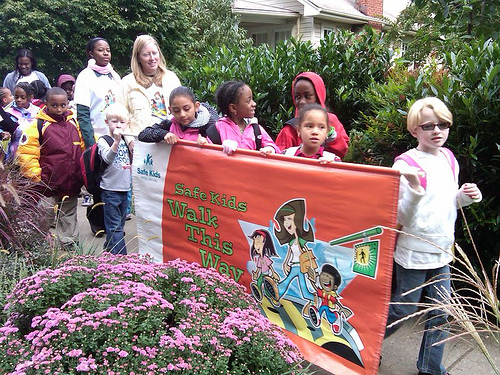In Jeff Speck’s excellent new book, Walkable City, he suggests that there are ten keys to creating walkability. Most of them also have something to do with redressing the deleterious effects caused by our allowing cars to dominate urban spaces for decades.
Here are the author’s ten steps of walkability, with a memorable line from his description of each:
 1. Put cars in their place.
1. Put cars in their place.
(“Traffic studies are bullshit.”) Startling quote, no? Jeff believes, that a car-first approach has hurt American cities. This is in part because traffic engineers too often have failed to acknowledge that increased roadway traffic capacity can lead to more, not fewer, cars on the road. The resulting phenomenon of “induced demand” results in unanticipated consequences not only for traffic on freeways but especially in neighborhoods and downtowns, where streets are sometimes treated not as critical public spaces for animating city life but as conveyances for motor vehicles. Jeff generally supports congestion pricing, but cautions that we must be very careful about assuming the merits of pedestrian-only zones.
2. Mix the uses.
(“Cities were created to bring things together.”) The research shows that neighborhoods with a diversity of uses – places to walk to – have significantly more walking than those that don’t. Jeff makes the point that, for most American downtowns, it is housing – places to walk from, if you will – that is in particularly short supply. He also points out, quite correctly, that for most (still-disinvested) downtowns, affordability is not much of an issue, because relatively affordable housing is all there is. For those booming downtowns susceptible to gentrification, he recommends inclusionary zoning and “granny flats,” or accessory dwelling units.
3. Get the parking right.
(“Ample parking encourages driving that would not otherwise occur without it.”) As do many progressive city thinkers, Jeff points out that we have a huge oversupply of underpriced parking, in large part due to minimum parking requirements for buildings and businesses. A side effect is that adaptive reuse of historic properties can be discouraged, because there isn’t sufficient space to create parking required for the buildings’ new uses. Jeff recommends consolidated parking for multiple buildings and businesses and higher prices, especially for curb parking, and shares a number of successful examples.
From our partners:
4. Let transit work.
(“While walkability benefits from good transit, good transit relies absolutely on walkability.”) Jeff cites the disappointing experience of light rail in Dallas as an example of what not to do to support transit: insufficient residential densities, too much downtown parking, routes separated from the busiest areas, infrequent service, and a lack of mixed-use, walkable neighborhoods near the stops. Jeff recommends concentrating on those transit corridors that can be improved to support ten-minute headways, and working there to simultaneously improve both the transit and the urban fabric. Quoting transportation planner Darrin Nordahl, Jeff also reminds us that public transportation is “a mobile form of public space,” and thus should be treated with respect and made pleasurable.
5. Protect the pedestrian.
(“The safest roads are those that feel the least safe.”) Here again, it comes back to driving. Jeff asserts that roadway “improvements” that facilitate car traffic – such as wider lanes or one-way streets – encourage higher speeds; thus, we should instead use narrow lanes and two-way streets. Intriguingly, he argues – as have other new urbanists – for stripping some roadways of signage and mode delineation. The idea is that, if drivers feel they might hit someone or something, they really will slow down or change routes. Jeff supports on-street curbside parking, because it buffers the sidewalk from moving vehicle traffic.
6. Welcome bikes.
(“In Amsterdam, a city of 783,000, about 400,000 people are out riding their bikes on any given day.”) This step is only minimally about walkability, except for the point that bike traffic slows car traffic. It’s all about making cities more hospitable to cycling, which many U.S. cities are now doing. Although the drivers complain, the research suggests that car traffic isn’t really inconvenienced much if at all when the addition of cycling infrastructure is thoughtful. Jeff does discuss the very interesting point that some experienced cyclists actually prefer riding in the main roadway rather than in a designated lane.
7. Shape the spaces.
(“Get the design right and people will walk in almost any climate.”) This chapter is mostly about providing the sense of enclosure we need to feel comfortable walking. And, once again, the main villain is the car, this time in the form of surface parking lots along the walkway. But Jeff also takes some shots at blank walls (correctly) and look-at-me architecture. He believes that the amount of density to support good city walkability does not necessarily require tall buildings.
8. Plant trees.
Even though street trees correlate with fewer automobile accidents, many public transportation agencies seek to limit them because they believe they interfere with visibility. But Jeff points out that, in addition to contributing to auto safety, trees provide myriad public benefits, including natural cooling, reduced emissions and energy demand for air conditioning, and reduced stormwater pollution.
9. Make friendly and unique [building] faces.
(“Pedestrians need to feel safe and comfortable, but they also need to be entertained.”) Of the ten steps, this is the one most about design, or at least the most about design of things other than roadways. Stores and businesses with street-level windows help (meaning that most banks and drugstores don’t), as does disguised or lined parking, vertical building lines, and architectural details.
10. Pick your winners.
(“Where can spending the least money make the most difference?”) The subtitle here could well be, “in the real world, you can’t do everything.” True enough. Jeff argues for focusing on downtowns first, and on short corridors that can connect walkable neighborhoods.
Walkable City is like David’s presentations. It’s really a political text about why he believes we need to do these things, the objectives we should strive for (rather than the design solutions), and the obstacles that stand in the way, which he debunks one by one. There is not a single visual image in the book, and really only a handful of verbal descriptions of successful walkable places. This book is intended to motivate more than to illustrate.
Walking versus driving
The book’s opening chapter, before Jeff gets into the ten steps, is devoted to the rapidly increasing demand for walkable places and to an indictment of our car-oriented cities, which “have effectively become no-walking zones.” A “public realm that is unsafe, uncomfortable, and just plain boring” will not work for creative young people, he says, because they value a pedestrian culture that, among other things, creates opportunities for chance encounters that turn into friendships. Indeed, as others (including myself) have pointed out, the entry of the millennial generation into the housing market at the same time that baby boomers are retiring is dramatically strengthening the market for walkable places.
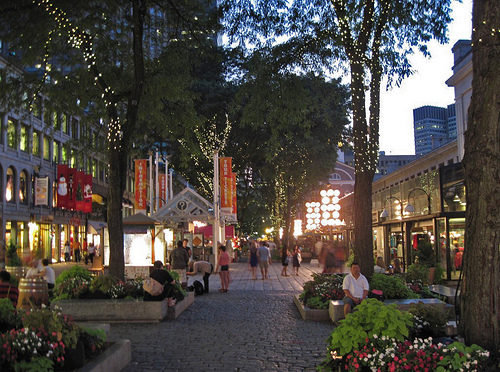
The conventional wisdom used to be that creating a strong economy came first, and that increased population and a higher quality of life would follow. The converse now seems more likely: creating a higher quality of life is the first step to attracting new residents and jobs.
Vancouver and Portland, Jeff argues, are among the places that are doing just that.
Making driving less convenient, more difficult, and more expensive will be good for walkers and for cities. There are losers as well as winners in this approach to walkability.
Parks and greenery
To suggest that parks discourage walking is to ignore the experience of the Jardin du Luxembourg in Paris, Russell Square in London, and St. Stephen’s Green in Dublin. We need respite and calm in cities as much as we need liveliness.
Congestion can be good
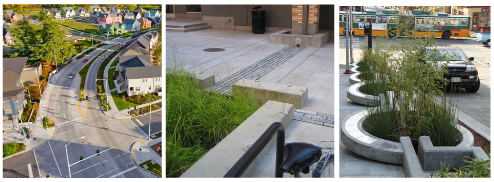
The most commonly discussed form of congestion pricing is called “cordon pricing,” under which drivers are charged for entering downtown at certain times of day. It works in London, and might even work in New York, cities whose downtowns are so strong that they can withstand being taxed in a way that their suburbs are not. But the last thing that still-recovering downtowns need is to give people and businesses another reason not to go there. Besides, here in D.C., the suburban roadways are far more congested than those in the city.
The bottom line is that Walkable City is very good indeed, a worthy addition to the canon of urban thinking. The subject matter is critical. For those of us who think about cities for a living, this well-annotated treatise can help organize our thoughts and point us to helpful research and opinion. For those outside the field but in a position to do something, it summarizes some of the best thinking on what to do to tame the car culture and make cities more walkable. For those who are merely interested or who may be curious, it will change the way you see cities. You can find Walkable City at your favorite bookstore or access it from Jeff’s website, which is pretty interesting in itself.
This article appeared on CityLab.









